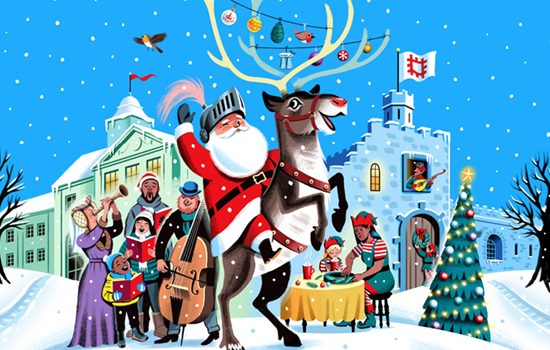1. Originally gingerbread was made with honey and breadcrumbs
One of the earliest English recipes for gingerbread, written down in the fifteenth century, didn’t actually contain any ginger! Instead bread crumbs or ‘gratyd brede’ were mixed with boiled honey and formed into a stiff paste with saffron and pepper. The gingerbread was then shaped into a square, sprinkled with cinnamon and decorated with box leaves secured with cloves. Sometimes it was also coloured red by adding ‘sanders’ – the finely ground bark of the red sandalwood tree. Later recipes even include liquorice and red wine!
Spices were an expensive rarity and the use of excessive saffron in gingerbread was a way of demonstrating wealth to guests.
2. Queen Elizabeth once served her guests miniature gingerbread versions of themselves
Medieval gingerbread served a more practical purpose and was used as a sweetmeat at the end of a meal to aid digestion and sweeten the breath. By the Elizabethan period this restorative property of gingerbread was still widely accepted, and gingerbread was described as ‘a kind of cake or paste made to comfort the stomach’: it was also believed to be good for flatulence and sharpening the sight!
The Tudors enjoyed gingerbread at feasts and state events: Queen Elizabeth once impressed her guests by serving them miniature gingerbread forms of themselves.
3. Children could learn the alphabet using gingerbread letters
By the seventeenth century gingerbread was more accessible to the general population. Honey became replaced by the cheaper alternative of treacle and flour was used in place of breadcrumbs. Gingerbread was still considered a treat to be eaten on special occasions and it was thought to be good luck to eat gingerbread bought at a fair. This form of gingerbread was known as ‘fairings’ and wooden moulds were used to shape edible characters and simple objects. Popular designs included Kings and Queens and the gingerbread alphabet block known as a hornbook, which had the benefit of being both educational and providing a delicious incentive for pupils to learn their letters – each one correctly memorised could be nibbled away. Gingerbread of this period was often decorated with Dutch gold (a mixture of copper and zinc which looks like real gold).
4. Queen Victoria enjoyed sharing gingerbread with her dog
Gingerbread was enjoyed in Queen Victoria’s household from a young age and a 14-year-old Victoria gifted her beloved King Charles Spaniel, Dash ‘two bits of gingerbread surrounded with branches of holly and candles’ at Christmas time. Later during Queen Victoria’s reign, she shared this Yuletide gingerbread tradition with her family; her husband, Prince Albert, would dress up as Saint Nicholas and give his children gingerbread and apples for being well-behaved children during the year.
Another famous Victorian, Charles Dickens also revealed a love of gingerbread: an old Dickens family recipe reveals that the type he ate was more like a cake than a biscuit, with the added ingredient of rum.
5. The iconic gingerbread house from Hansel and Gretel was not made of gingerbread
Gingerbread houses likely originated in Germany between the sixteenth and eighteenth centuries, spreading to England at some stage in the nineteenth century. In Thomas Hardy’s novel ‘Jude the Obscure’ (1896), the character of Jude Fawley builds gingerbread houses, known as ‘Christminster Cakes’, complete with ‘traceried windows, and cloisters’.
In the popular myth of Hansel and Gretel, the witch lures the unfortunate children into captivity with her irresistible cottage made of gingerbread covered with sweets. However, the original Grimm’s fairy tale describes a house made from bread, with a cake roof and sugar windows but modern retellings increase the sugary temptation by upgrading mere bread to gingerbread.
Make your own gingerbread treats
Now you've discovered 5 facts about gingerbread, why not have a go at making your own?
Download the RecipeAdapted from an article for English Heritage by food historian Sam Bilton. Read the full text here. Sam is a food historian, supper club host and author of First Catch Your Gingerbread sambilton.com
MORE TO EXPLORE
-

Christmas
Whether you're looking for dazzling light displays, the wardrobe leading to Narnia or the chance to meet Father Christmas, make this season magical with festive events for the whole family.
-

Become a member
Treat the whole family to adventure and uncover the fascinating history of England with an annual membership, giving you access to hundreds of sites across the UK.
-

THE ENGLISH HERITAGE PODCAST
Join presenter Charles Rowe as we bring the history of our sites to life with news, views and expert interviews across over 100 episodes.
